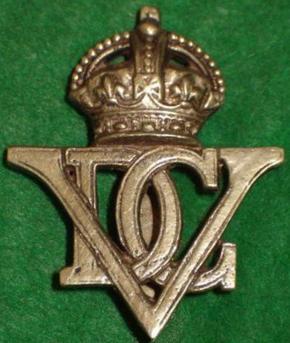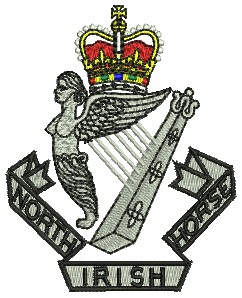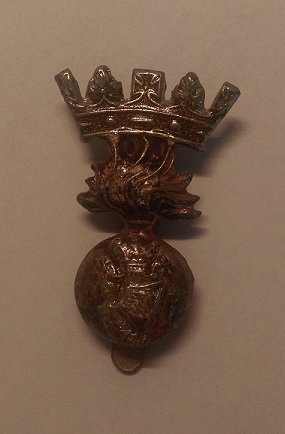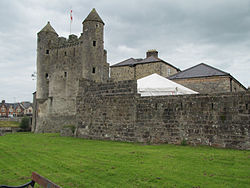
County Fermanagh is one of the thirty-two counties of Ireland, one of the nine counties of Ulster and one of six counties of Northern Ireland

Enniskillen is the largest town in County Fermanagh, Northern Ireland. It is in the middle of the county, between the Upper and Lower sections of Lough Erne. It had a population of 13,823 at the 2011 Census. Enniskillen Castle was built in the 15th century as a stronghold of the Maguires, before coming under English control in the early 17th century. The castle and town were expanded during the Plantation of Ulster. It was the seat of local government for the former Fermanagh District Council, and is the county town of Fermanagh.

Eric Norman Frankland Bell VC was an Irish recipient of the Victoria Cross, the highest and most prestigious award for gallantry in the face of the enemy that can be awarded to British and Commonwealth forces. A soldier with The Royal Inniskilling Fusiliers during the First World War, he was posthumously awarded the VC for his actions on 1 July 1916, during the Battle of the Somme.

The 5th Royal Inniskilling Dragoon Guards was a cavalry regiment of the British Army formed in 1922 by the amalgamation of the 5th Dragoon Guards and the 6th (Inniskilling) Dragoons. It served in the Second World War and the Korean War. In August 1992, as a consequence of the Options for Change defence cuts, the regiment was amalgamated with the 4th/7th Royal Dragoon Guards to form the Royal Dragoon Guards.

The Royal Inniskilling Fusiliers was an Irish line infantry regiment of the British Army in existence from 1881 until 1968. The regiment was formed in 1881 by the amalgamation of the 27th (Inniskilling) Regiment of Foot and the 108th Regiment of Foot.

The North Irish Horse was a yeomanry unit of the British Territorial Army raised in the northern counties of Ireland in the aftermath of the Second Boer War. Raised and patronised by the nobility from its inception to the present day, it was one of the first non-regular units to be deployed to France and the Low Countries with the British Expeditionary Force in 1914 during World War I and fought with distinction both as mounted troops and later as a cyclist regiment, achieving eighteen battle honours. The regiment was reduced to a single man in the inter war years and re-raised for World War II, when it achieved its greatest distinctions in the North African and Italian campaigns. Reduced again after the Cold War, the regiment's name still exists in B Squadron, the Scottish and North Irish Yeomanry and 40 Signal Squadron, part of 32 Signal Regiment.

The Royal Irish Fusiliers (Princess Victoria's) was an Irish line infantry regiment of the British Army, formed by the amalgamation of the 87th (Prince of Wales's Irish) Regiment of Foot and the 89th (Princess Victoria's) Regiment of Foot in 1881. The regiment's first title in 1881 was Princess Victoria's (Royal Irish Fusiliers), changed in 1920 to the Royal Irish Fusiliers (Princess Victoria's). Between the time of its formation and Irish independence, it was one of eight Irish regiments.

The 6th (Inniskilling) Dragoons was a cavalry regiment in the British Army, first raised in 1689 as Sir Albert Cunningham's Regiment of Dragoons. One of the regiment's most notable battles was the Battle of the Boyne in July 1690. It became the 6th (Inniskilling) Regiment of Dragoons in 1751. The regiment also fought with distinction in the Charge of the Union Brigade at the Battle of Waterloo and again as part of the successful Charge of the Heavy Brigade against superior numbers at the Battle of Balaclava during the Crimean War. The First World War sounded the death knell for mounted cavalry as it became apparent that technology had moved forward with greater destructive power and made horsed cavalry redundant on the modern battlefield. The British Army reorganised and reduced its cavalry corps by disbanding or amalgamating many of its famous cavalry regiments. The Inniskillings was one of those affected. It saw service for two centuries, including the First World War, before being amalgamated with 5th Dragoon Guards to form 5th/6th Dragoons in 1922.
In countries whose armies are organised on a regimental basis, such as the army of the United Kingdom, a regimental museum is a military museum dedicated to the history of a specific army regiment.
Connor Maguire, 2nd Baron of Enniskillen was an Irish nobleman from Ulster who took part in the Irish Rebellion of 1641. He was executed for high treason.

The regimental depot of a regiment is its home base for recruiting and training. It is also where soldiers and officers awaiting discharge or postings are based and where injured soldiers return to full fitness after discharge from hospital before returning to full duty. Normally, a variety of regimental stores will also be kept at the depot. The regimental depot is not the same as the regimental headquarters, though in practice the two will often be co-located in the same place.
"The Enniskillen Dragoon" is an Irish folk song associated with the Inniskilling Dragoons, a British Army regiment based at Enniskillen, County Fermanagh, in what is now Northern Ireland. The air was used as the regiment's signature quick march. The oldest lyrics tell of the love of a local lady for a soldier serving in the eponymous regiment.

The siege of Enniskillen took place at Enniskillen in Fermanagh, Ireland, in 1594 and 1595, during the Nine Years' War. In February 1594, the English had captured Enniskillen Castle from the Irish after a waterborne assault and massacred the defenders after they surrendered. From May 1594, an Irish army under Hugh Maguire and Cormac MacBaron O'Neill besieged the English garrison in the castle, and in August they defeated an English relief force. A second relief force was allowed to resupply the garrison, but the castle remained cut off. Eventually, in May 1595, the English garrison surrendered to the Irish and were then massacred.

The Battle of the Ford of the Biscuits took place in Fermanagh, Ireland on 7 August 1594, during the Nine Years' War. A column of almost 650 English troops led by Sir Henry Duke was ambushed and defeated by a Gaelic Irish force under Hugh Maguire and Cormac MacBaron O'Neill at the Arney River. The English column had been sent to relieve and resupply Enniskillen Castle, which had been under siege by the Irish since May. The English suffered at least 56 killed and 69 wounded, and were forced to make a hasty retreat.
The Battle of Belleek, also known as the Battle of the Erne Fords, was fought on the River Erne near Belleek in Fermanagh, Ireland, on 10 October 1593. It was part of the buildup to the Nine Years' War. The battle was fought between a Gaelic Irish army under Hugh Maguire, lord of Fermanagh—who had begun a revolt against the English—and an English Crown expeditionary force under Sir Henry Bagenal, supported by Hugh O'Neill, Earl of Tyrone. Maguire's force was defeated, but the bulk of his army was unscathed. Hugh O'Neill would later join Maguire in war against the English.

The County Fermanagh War Memorial stands in Enniskillen, County Fermanagh, Northern Ireland. It was originally constructed to commemorate the men of the town killed during the First World War, particularly those serving with the local regiments, the 6th (Inniskilling) Dragoons and the Royal Inniskilling Fusiliers. It was later altered to also commemorate those killed in the Second World War.

Enniskillen Town Hall is a municipal structure in The Diamond in Enniskillen, County Fermanagh, Northern Ireland. The town hall, which is one of the meeting places of Fermanagh and Omagh District Council, is a Grade B+ listed building.
Colonel Rory Maguire was an Irish politician and soldier. He was a leading instigator of the Irish Rebellion of 1641 and subsequently participated in the Irish Confederate Wars as a senior Confederate commander.
Sir William Cole was an English soldier and politician, who participated in the Plantation of Ulster and established a settler town at Enniskillen, County Fermanagh. Despite his initial loyalty to the Stuarts, he was a leading English Parliamentarian figure in the Irish Confederate Wars of the 1640s.
















